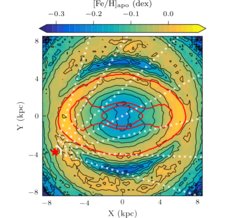The Milky Way's middle-aged inner ring
Wylie, S. M., Clarke, J. P., Gerhard, O., 2022, A&A, 659, A80

APOGEE orbits. The red star marks the position of the Sun, while the white dashed lines mark
different sight lines. Important density levels, plotted in red, show a bar encircled by a ring-like
structure.
With the advent of Gaia which provides 6D phase space information, we can now obtain the orbits of many inner Milky Way stars in addition to their chemical and age information. Orbits give us two big advantages: (i) orbits fill a 3D volume making structures easier to see and interpret and (ii) different components should be composed of different types of orbits. In Wylie et al. 2022, we used APOGEE DR16 orbits integrated in a state of the art potential that was fit to multiple bulge data sets to build detailed orbital density, metallicity, and age maps. We find that a significant amount of APOGEE orbits trace a vertically thin, radially thick elongated ring between 4 and 6 kpc from the Galactic centre. The inner radii of this ring overlap with the ends of the flat bar protruding from the Milky Way’s 3D b/p bulge. This ring is on average solar in metallicity and about 6 Gyr in age. The bar can be seen in Fig. 1 as the inner red contour while the ring is visible in the metallicity as a roughly solar ring surrounding the bar. As rings are
believed to form from a bar’s 4:1 resonance, the ring must come after the bar. Therefore in Wylie et al. 2022 by comparing the age distribution of the ring stars to that of the bar stars, we estimate that the bar must have formed at least 7 Gyr age.
